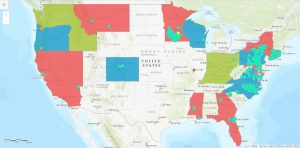Compared to similar market-based environmental programs that aim to address climate change or protect endangered wildlife, participation in water quality trading (WQT) programs has remained low in the U.S. for decades.

Several market-based approaches to conservation, such as emissions trading and wetland mitigation banking, have attracted widespread participation from entities subject to environmental regulations. However, water quality trading (WQT) programs have proven less popular. This map from the U.S. Environmental Protection Agency (EPA) shows all WQT agreements in place in the U.S. as of 2016. Photo courtesy EPA
According to a recent report, Breaking Down Barriers: Priority Actions for Advancing Water Quality Trading, a major reason why potential buyers and sellers hesitate to take advantage of WQT programs is because the learning curve is too steep. The report, produced by a group of representatives from wastewater utilities, agricultural groups, regulators, and WQT facilitators called the National Network on Water Quality Trading (NNWQT), provides an action-oriented guide to drive design of and demand for more navigable WQT programs.
Success requires guidance and clarity
WQT typically occurs when an entity that discharges pollutants into waterways builds new infrastructure or undertakes new practices that clean up their discharges beyond regulatory requirements, generating “credits” based on the difference. Other dischargers in the same watershed can then purchase those credits, applying the extra pollution-mitigation benefits toward their own regulatory requirements.
NNWQT conducted more than 50 interviews with regulators, utility managers, nonprofits, and other stakeholders to identify ways to remove barriers to WQT and spread the word about its benefits. While the U.S. Environmental Protection Agency (EPA) broadly promoted WQT programs as a way to meet watershed-scale objectives in 2003, the report found that many would-be traders were unclear on whether local- and state-level regulators would recognize their WQT transactions.
The landscape is even murkier for municipal separate storm sewer system (MS4) permittees, for which no federal-level guidance currently exists. In its absence, many cities look to examples set by stormwater-trading pioneers such as Washington D.C. with its Stormwater Retention Credit Trading Program and Nevada and California with their Lake (Tahoe) Clarity Crediting Program. Because these programs measure credits based on runoff retention volume rather than pollutant loads, which are measured by traditional WQT programs, administrators of both credit markets spent considerable resources to adapt the WQT model. Many municipalities that could stand to benefit from stormwater credit trading do not have the resources to experiment for themselves without a standardized model to work from, the report finds.
“We think it could be faster and easier to build good, defensible programs that give permittees credit for investing in their watersheds, through trading and other types of market-based approaches,” said Kristiana Teige Witherill, who facilitates the NNWQT on behalf of the Willamette Partnership (Portland, Ore.). “The suite of priority actions proposed in this report provide a path forward for breaking down the barriers that have kept water quality markets from advancing in the United States.”
A plan of action
The report outlines how stakeholders at all levels can contribute to more accessible WQT programs, structure deals that reduce risks, and do their part to improve waterway health. The report’s recommendations are segmented by role and include the following.
-

According to a new report by a coalition of wastewater utilities, agricultural groups, regulators, and WQT facilitators, complexity is one of the greatest barriers to wider adoption of WQT programs. Uncertainty around whether purchased credits will apply toward specific permit requirements is another obstacle. The report lays out several actions stakeholders at all levels can take to promote sound WQT programs. Photo courtesy rawpixel/Pixabay
Water quality permittees can map out all potential WQT partners in the watershed and open lines of communication.
- Nonprofit partners can develop cost assessments and a compendium of successful WQT deals to aid others in program design and implementation.
- State regulators can dedicate at least one staff member to WQT program administration.
- EPA can work with stakeholders to update and clarify federal guidance on WQT policies.
- Law firms can create contract templates to help minimize legal uncertainty when brokering WQT arrangements.
Download a PDF of the full report from the Willamette Partnership website.






